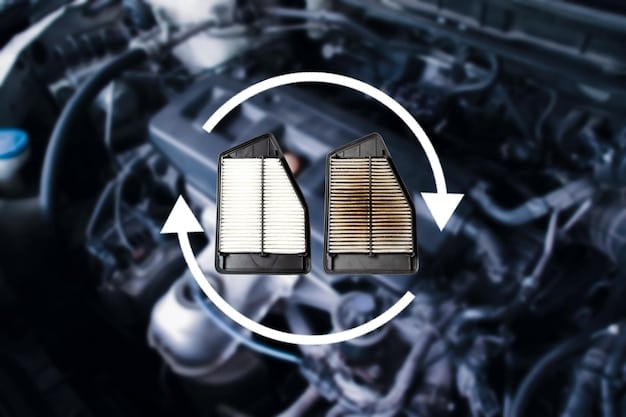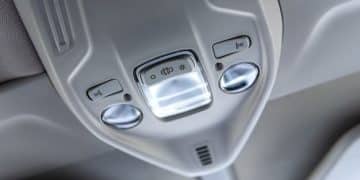Understanding the New Federal Fuel Efficiency Standards for US Automakers in 2025

Understanding the New Federal Fuel Efficiency Standards in 2025 is crucial for US automakers as they navigate stricter regulations, invest in electric vehicle technology, and strive to meet consumer demands for more fuel-efficient vehicles.
The automotive industry is on the cusp of a significant transformation, driven in large part by evolving environmental regulations. For US automakers, understanding the new Federal Fuel Efficiency Standards in 2025 is not just about compliance; it’s about staying competitive and innovative in a rapidly changing market.
Overview of the Federal Fuel Efficiency Standards
The Federal Fuel Efficiency Standards, also known as Corporate Average Fuel Economy (CAFE) standards, are regulations set by the US government to improve the average fuel economy of cars and light trucks produced for sale in the United States. These standards have been in place for decades and are periodically updated to reflect advancements in technology and evolving environmental goals.
Understanding the historical context and the current state of these standards is key to grasping their future implications. The standards for 2025 represent a significant step up in stringency, requiring automakers to achieve substantial improvements in fuel efficiency across their fleets.
Historical Context of CAFE Standards
The CAFE standards were first established in 1975 in response to the oil crisis. The goal was to reduce the nation’s dependence on foreign oil and improve energy security. Over the years, the standards have been revised and strengthened, leading to significant improvements in vehicle fuel economy.
Current State of Fuel Efficiency Regulations
As of 2023, the fuel efficiency regulations continue to evolve, addressing advancements in automotive technology and shifts in market demands. Automakers are increasingly investing in electric vehicles (EVs) and hybrid technologies to meet these standards.
Key aspects of the current state include:
- Stringent Targets: The standards for 2025 and beyond require significant improvements in fuel economy.
- Flexibility Mechanisms: Automakers can utilize various credits and flexibilities to meet the standards.
- Enforcement: The EPA and NHTSA play key roles in enforcing the standards.
In conclusion, a comprehensive understanding of the Federal Fuel Efficiency Standards’ history and present form is essential for automakers to navigate the evolving regulatory landscape effectively.
Key Changes Coming in 2025
The year 2025 marks a pivotal point for fuel efficiency standards in the US automotive market. Several key changes are set to take effect, which will significantly impact how automakers design, manufacture, and sell their vehicles.
These changes are designed to accelerate the transition to more fuel-efficient vehicles and reduce greenhouse gas emissions. Understanding these changes is crucial for strategic planning and compliance.

Increased Stringency of Fuel Efficiency Targets
One of the most significant changes is the increased stringency of the fuel efficiency targets. The standards for 2025 require automakers to achieve a higher fleet-wide average fuel economy than in previous years. This means that automakers will need to make greater strides in improving the efficiency of their vehicles.
Impact on Automakers
The increased stringency of the standards will have a significant impact on automakers:
- Investment in Technology: Automakers will need to invest heavily in new technologies to meet the standards.
- Vehicle Design: Vehicle designs will need to be optimized for fuel efficiency.
- Production Strategies: Automakers may need to shift their production strategies to focus on more fuel-efficient vehicles.
Technological Adaptations Required
Automakers will need to adopt a variety of technological adaptations to meet the new standards:
- Advanced Engine Technologies: Implementing advanced engine technologies such as turbocharging and direct injection.
- Lightweight Materials: Using lightweight materials such as aluminum and carbon fiber.
- Electric Vehicle Technology: Investing in electric vehicle technology and increasing the production of EVs.
The changes coming in 2025 will require automakers to adapt and innovate. Those who can successfully navigate these changes will be well-positioned for success in the future.
Strategies for Compliance
To successfully navigate the new Federal Fuel Efficiency Standards in 2025, US automakers need to develop and implement effective strategies for compliance. These strategies should focus on technological innovation, production planning, and leveraging available flexibilities.
A proactive approach to compliance will not only help automakers avoid penalties but also drive innovation and improve their competitive position.
Technological Innovation and Investment
Investing in research and development is crucial for automakers to meet the new standards. This includes developing new engine technologies, exploring alternative fuels, and increasing the production of electric vehicles. Technological innovation is the cornerstone of compliance.
Consider these points:
- Electric Vehicle (EV) Production: Increase the production and sales of EVs to offset less efficient vehicles.
- Hybrid Technology: Invest in hybrid technology to improve the fuel efficiency of traditional vehicles.
- Advanced Materials: Use lightweight materials to reduce vehicle weight and improve fuel economy.
Production Planning and Optimization
Automakers need to optimize their production planning to ensure that they are producing a mix of vehicles that meet the fuel efficiency standards. This may involve shifting production towards more fuel-efficient models and reducing the production of less efficient vehicles.
Leveraging Available Flexibilities and Credits
The CAFE standards include a number of flexibilities and credits that automakers can use to meet the standards. These include credits for early adoption of new technologies, credits for producing vehicles that exceed the standards, and credits for using alternative fuels. Automakers should take full advantage of these flexibilities to minimize the cost of compliance.
Effectively using flexibilities involves:
- Credit Trading: Engaging in credit trading with other automakers to balance fleet-wide averages.
- Technology Credits: Applying for credits for implementing advanced fuel-saving technologies.
- Alternative Fuel Credits: Utilizing credits for producing vehicles that run on alternative fuels like biofuels or electricity.
In summary, compliance with the 2025 Federal Fuel Efficiency Standards requires a multifaceted approach that combines technological innovation, production optimization, and strategic use of available flexibilities.
Impact on Vehicle Design and Manufacturing
The new Federal Fuel Efficiency Standards are poised to influence virtually every aspect of vehicle design and manufacturing. Automakers are re-evaluating their approaches to vehicle construction, materials, and engine technology to meet increasingly stringent requirements.
These changes will not only improve fuel efficiency but also drive innovation in the automotive industry.

The Push for Lightweight Materials
One of the most significant impacts of the new standards is the push for lightweight materials. Automakers are increasingly using aluminum, carbon fiber, and other lightweight materials to reduce vehicle weight and improve fuel economy. This trend is expected to accelerate in the coming years.
Advanced Engine Technologies
Another key area of focus is advanced engine technologies. Automakers are investing in new engine designs that are more fuel-efficient and produce fewer emissions. These technologies include turbocharging, direct injection, and variable valve timing.
New Engine Tech Includes:
- Turbocharging: Implementing turbochargers to boost engine power without increasing engine size.
- Direct Injection: Using direct fuel injection to improve combustion efficiency.
- Variable Valve Timing: Applying variable valve timing to optimize engine performance at different speeds.
Electric Vehicle (EV) and Hybrid Vehicle Production
The shift towards electric vehicles (EVs) and hybrid vehicles is also being driven by the new standards. Automakers are investing heavily in EV and hybrid technology to meet the standards and capitalize on the growing demand for these vehicles. This trend is expected to continue in the coming years.
The integration of EVs and hybrids in factories includes:
- Dedicated EV Production Lines: Establishing dedicated production lines for electric vehicles.
- Battery Technology: Innovating in battery technology to improve range and reduce charging times.
- Hybrid Powertrains: Developing more efficient hybrid powertrains to combine electric and combustion power effectively.
In conclusion, the impact on vehicle design and manufacturing will be profound, leading to lighter vehicles, more efficient engines, and a greater focus on electric and hybrid technology.
Consumer Implications and Market Trends
The new Federal Fuel Efficiency Standards not only affect automakers but also have significant implications for consumers and broader market trends. As fuel efficiency standards become stricter, consumers can expect to see changes in vehicle prices, fuel costs, and the types of vehicles available.
Understanding these implications is crucial for consumers to make informed purchasing decisions and for automakers to align their offerings with consumer preferences.
Potential Changes in Vehicle Prices
The new standards could lead to changes in vehicle prices. Automakers may need to pass on the costs of developing and implementing new technologies to consumers. This could result in higher prices for some vehicles, particularly those with advanced fuel-saving technologies.
However, the adoption of incentives and rebates could influence vehicle costs:
- Government Incentives: Utilizing government incentives to reduce the cost of fuel-efficient vehicles.
- Rebates: Offering rebates to encourage consumers to purchase more fuel-efficient models.
- Tax Credits: Providing tax credits for the adoption of electric and hybrid vehicles.
Fuel Cost Savings for Consumers
While vehicle prices may increase, consumers can also expect to see fuel cost savings over the life of their vehicles. More fuel-efficient vehicles will require less fuel to operate, resulting in lower fuel bills. This can offset the higher purchase price of these vehicles over time.
Shift Towards Electric and Hybrid Vehicles
One of the most significant market trends is the shift towards electric and hybrid vehicles. As fuel efficiency standards become stricter, automakers are investing more in EV and hybrid technology. This is leading to a greater availability of these vehicles in the market and increased consumer adoption.
The market is seeing:
- Increased EV Sales: Observing substantial growth in electric vehicle sales year over year.
- Hybrid Popularity: Witnessing increased demand for hybrid vehicles as a transitional option.
- Infrastructure Development: Scaling up charging infrastructure to support the growing number of EVs on the road.
In summary, understanding the implications for consumers includes changes in vehicle prices, potential fuel cost savings, and a continued shift toward electric and hybrid vehicles.
The Role of Government Incentives and Policies
Government incentives and policies play a crucial role in shaping the automotive market and driving the adoption of fuel-efficient vehicles. These incentives and policies can help to offset the costs of new technologies, encourage consumer adoption, and accelerate the transition to a more sustainable transportation system.
A supportive policy environment is essential for automakers to meet the new standards and for consumers to benefit from the advantages of fuel-efficient vehicles.
Tax Credits and Rebates
Tax credits and rebates are among the most common government incentives used to promote the adoption of fuel-efficient vehicles. These incentives can help to reduce the upfront cost of purchasing these vehicles, making them more accessible to consumers. Tax credits are typically offered at the federal level, while rebates may be offered at the state or local level.
Tax Credits may include:
- Federal Tax Credits: Utilizing federal tax credits to reduce the overall cost of purchasing EVs.
- State Tax Credits: Combining federal incentives with state-level tax credits for additional savings.
- Local Incentives: Taking advantage of city or county-level incentives to further lower the cost of EV ownership.
Infrastructure Investments
Government investments in charging infrastructure are also critical to the widespread adoption of electric vehicles. A lack of charging infrastructure can be a major barrier to EV adoption, particularly for consumers who live in apartments or do not have access to home charging. Government investments in charging infrastructure can help to overcome this barrier and make EVs more accessible to a wider range of consumers.
Regulatory Support and Mandates
In addition to incentives, regulatory support and mandates can also play a role in driving the adoption of fuel-efficient vehicles. For example, some states have adopted zero-emission vehicle (ZEV) mandates, which require automakers to sell a certain percentage of ZEVs in their state. These mandates can help to accelerate the transition to electric vehicles and ensure that automakers are investing in the technology.
Support policies involve:
- ZEV Mandates: Complying with zero-emission vehicle mandates to ensure a minimum percentage of EV sales.
- Fuel Efficiency Standards: Adhering to fuel efficiency standards to improve the overall efficiency of the vehicle fleet.
- Emission Regulations: Meeting stringent emission regulations to reduce the environmental impact of vehicles.
In conclusion, government incentives and policies play a crucial role in shaping the automotive market and driving the adoption of fuel-efficient vehicles.
| Key Aspect | Brief Description |
|---|---|
| ⚡️ Stricter Targets | Higher fuel efficiency standards for automakers to meet by 2025. |
| 🌱 Tech Innovations | Investment in EVs, lightweight materials, and advanced combustion engines. |
| 💰 Consumer Costs | Potential changes in vehicle prices and long-term fuel cost savings. |
| 🏛️ Gov. Support | Tax credits, infrastructure investments, and regulatory support for EVs. |
Frequently Asked Questions
▼
Corporate Average Fuel Economy (CAFE) standards are regulations in the United States to improve the average fuel economy of cars and light trucks sold in the US. They were first established in 1975.
▼
The CAFE standards are important because they reduce the nation’s dependence on foreign oil, improve energy security, and lower greenhouse gas emissions from the transportation sector, promoting a more sustainable environment.
▼
Automakers will need to invest more in fuel-efficient technologies such as electric vehicles (EVs) and advanced combustion engines to meet the stricter standards. This may also require changes to vehicle design and production processes.
▼
Automakers are likely to implement various technologies, including electric powertrains, hybrid systems, lightweight materials, advanced engine designs, and improved aerodynamics, to achieve compliance with the new fuel efficiency standards.
▼
Consumers may see higher initial vehicle prices due to advanced technology. Over time, they should experience lower fuel costs and reduced emissions, contributing to environmental sustainability and potential long-term savings.
Conclusion
As US automakers gear up for 2025, the new Federal Fuel Efficiency Standards present both challenges and opportunities. By embracing innovation, optimizing production, and leveraging available incentives, automakers can successfully navigate the changing landscape and contribute to a more sustainable transportation future.





